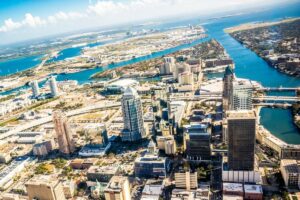Writer: Joshua Andino
 2 min read April 2022 — The lending space is changing, largely due to the popularity of the Small Business Administration (SBA)–backed loans and their newfound popularity after a banner 2021.
2 min read April 2022 — The lending space is changing, largely due to the popularity of the Small Business Administration (SBA)–backed loans and their newfound popularity after a banner 2021.
While fintechs and bank consolidation may provide more attention-grabbing headlines, a more subtle but perhaps even more impactful shift has begun, driven in large part by the SBA-backed lending programs that were essential in preventing widespread economic catastrophe during the early onset of the pandemic. As COVID-19 recedes, SBA-backed loans, such as the 7(a) or 504 lending program, offer businesses another tool when looking to jumpstart their expansions. They also provide the opportunity to secure new property and working capital.
SBA-backed loans had a record year in 2021. While they have unique conditions that differentiate them from traditional lending options, with factors such as the size of the business and conditions on where or how the money is spent being key considerations, it is likely they will remain a popular choice for lenders and businesses alike. Lower down payments and longer amortization periods are key characteristics that make SBA loans attractive to businesses. The 504 lending program in particular offers longer fixed rate periods. For its 7(a) loan program, the SBA provides the ability to fund loans that may not be fully collateralized, which is typically not the case under conventional loan terms.
Due to those reasons, many banks prior to the pandemic avoided SBA loans in favor of more traditional or lucrative lending options. However, for the U.S. economy, where 44% of activity is generated by small businesses, SBA-lending programs provide a strong opportunity for these businesses to access the funds needed to drive expansion. The pandemic changed any hesitancy surrounding the programs, fueled by the popularity of the paycheck protection program (PPP) and its success.
“A large swath of businesses, as well as banks, that may have shied away from SBA loan programs in the past were introduced to the SBA through PPP. That experience has led to more banks entering the SBA lending space. Additionally, more businesses have turned to the 504 program recently as indicated by the program hitting its lending cap,” Bill Habermeyer, CEO and president of Florida Business Development Corporation and a long-time SBA lender, told Invest: in a statement.
The SBA announced at the end of 2021 that it had a record year for each of its programs, providing $36.5 billion in 7(a) loans, which are specifically designed for small-business expansion. Another $8.2 billion was provided in 504 loans, a growth of 41% over the year according to Patrick Kelley, Associate Administrator for the Office of Capital Access in a press release. Funds were exhausted for the first time in the program’s history. In the SBA’s microloan program, which provides loans under $50,000, another $71.8 million had been provided to over 4,400 small businesses, 44% of those being Hispanic and Black-owned businesses. For a pre-pandemic comparison, the SBA provided $23.17 billion in 7(a) loans, and another $4.9 billion in 504 loans in 2019.
With the program hitting its absolute limits for 2021, Habermeyer remarked to Invest: what that success meant to FBDC and its clients: “That means we achieved our mission of providing access to capital to as many small businesses as possible. It also tells us that the amount that is authorized for this program should be looked into. We had additional small-business customers who needed our loans and they had to wait until the next fiscal year to obtain loan funds.” Lawmakers have worked to address the issue, with the Biden Administration’s fiscal year 2022 budget raising the 504 lending authorization cap to a total of $11 billion and an additional $4 billion for the 504 refinance without expansion program, as announced by the National Association of Development Companies.
While the SBA program had a record for 2021, the loans provided will help fuel growth across numerous cities in the United States. In Florida, Tampa has seen itself become an economic powerhouse as organizations from tech startups to established financial institutions look to capitalize on the bay’s massive growth. The expanded awareness around SBA lending will continue to fuel expansions for businesses across the region in a manner that remains effective and tailor-made to the needs of small businesses in particular.
“With Tampa’s hypergrowth, there are now many more customers than in the past,” Habermeyer noted. “Businesses that require a closer proximity to those customers can use the SBA 504 program to purchase new facilities. For existing businesses that just need operating capital they can refinance their existing buildings and get cash out to accommodate those needs.”
The new and growing popularity of SBA loans will continue to fuel demand for expanding the program even further. Prior to the passage of the FY22 budget, concerns were already rising that the 504 lending program would reach its limit. “[The] focus needs to be on enhancing the Small Loan Program so that businesses are better able to take advantage of SBA financing in a more streamlined manner so as to compete with the non-bank small-business lenders with egregious loan terms,” Habermeyer told Invest:.

